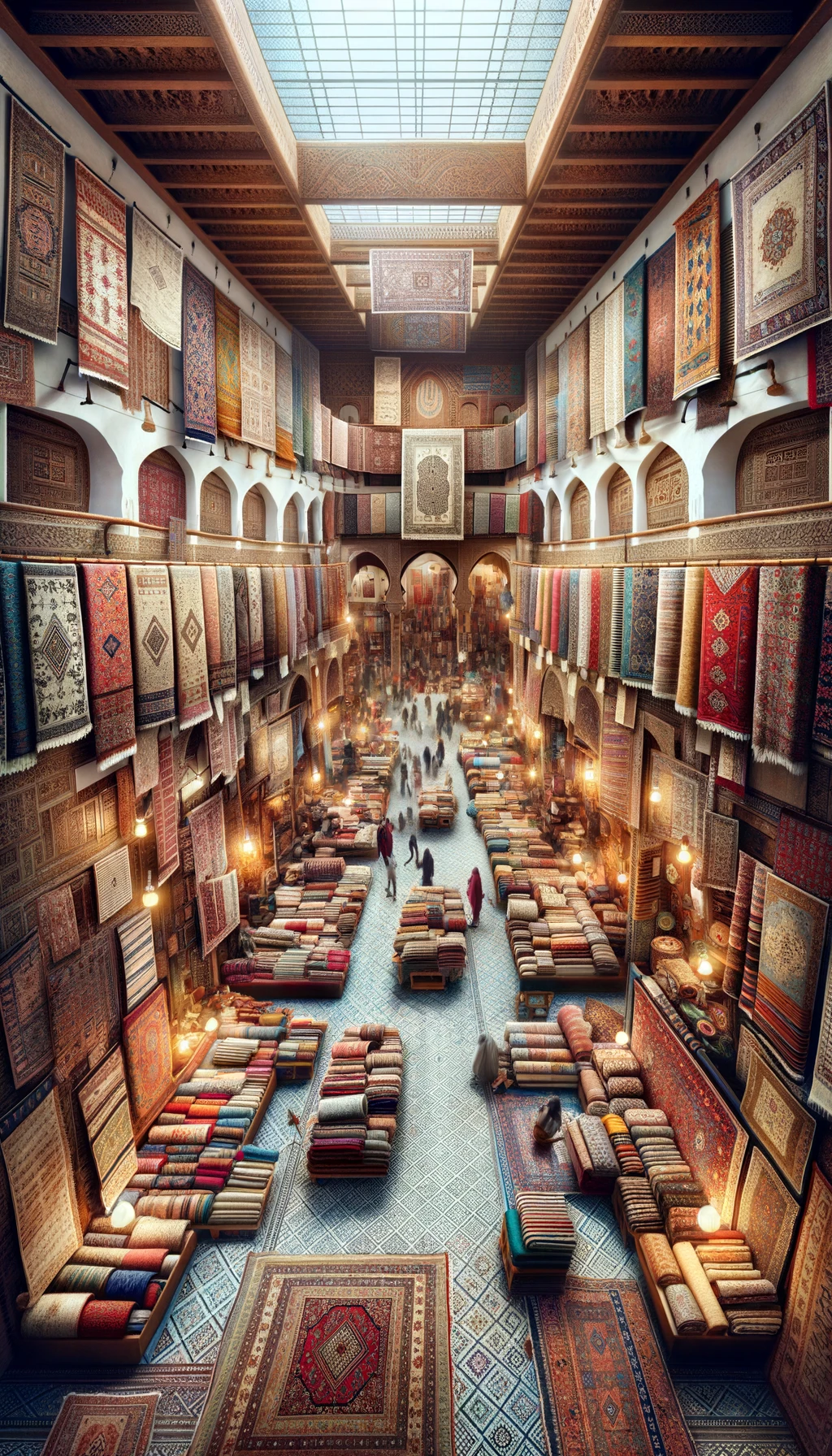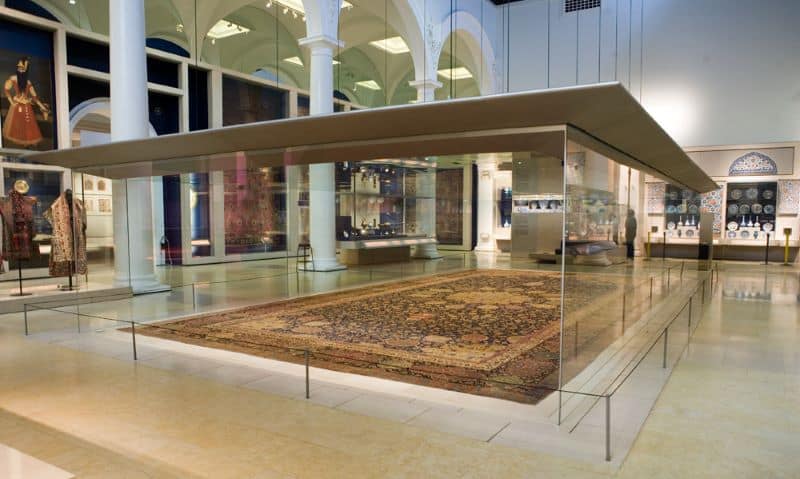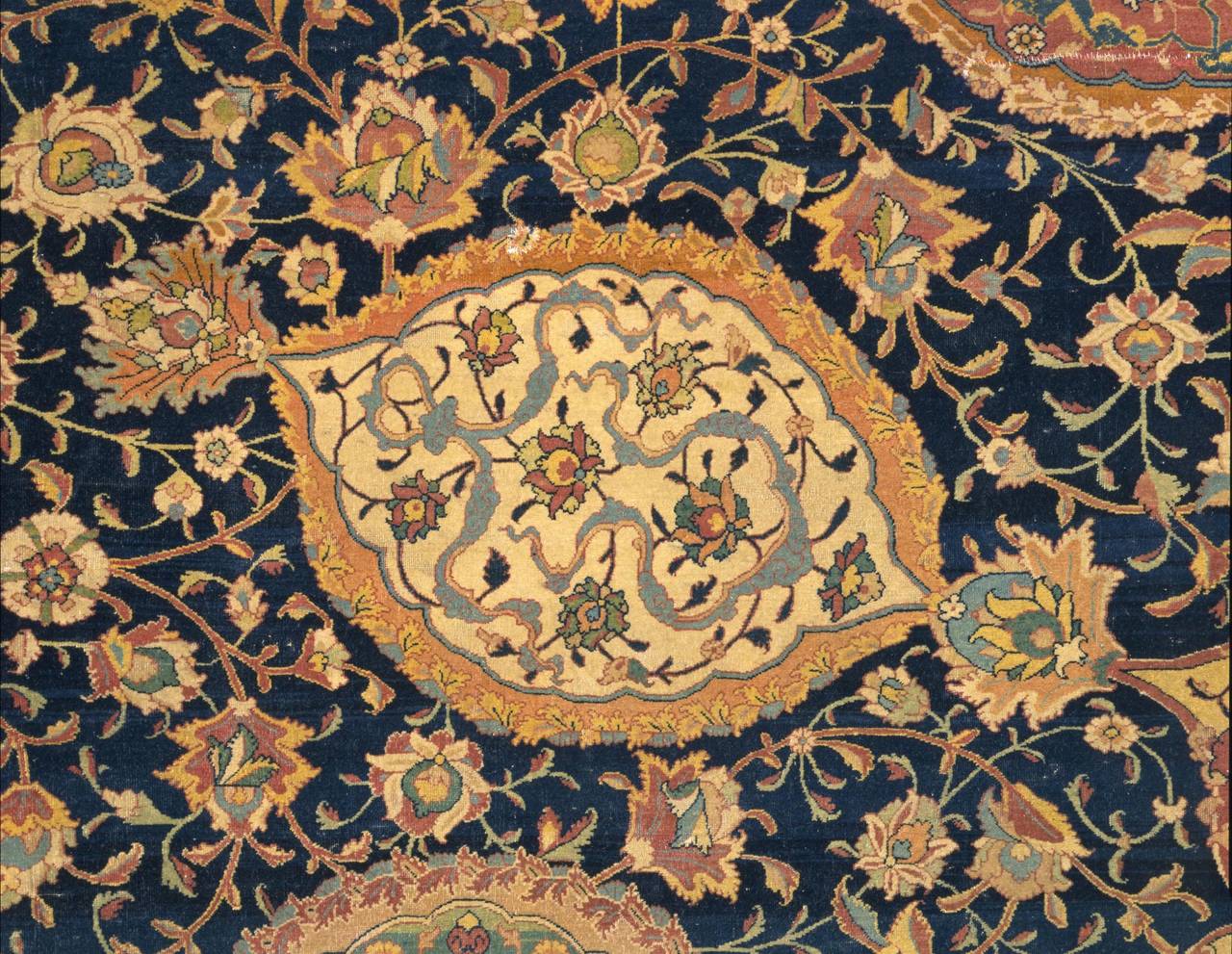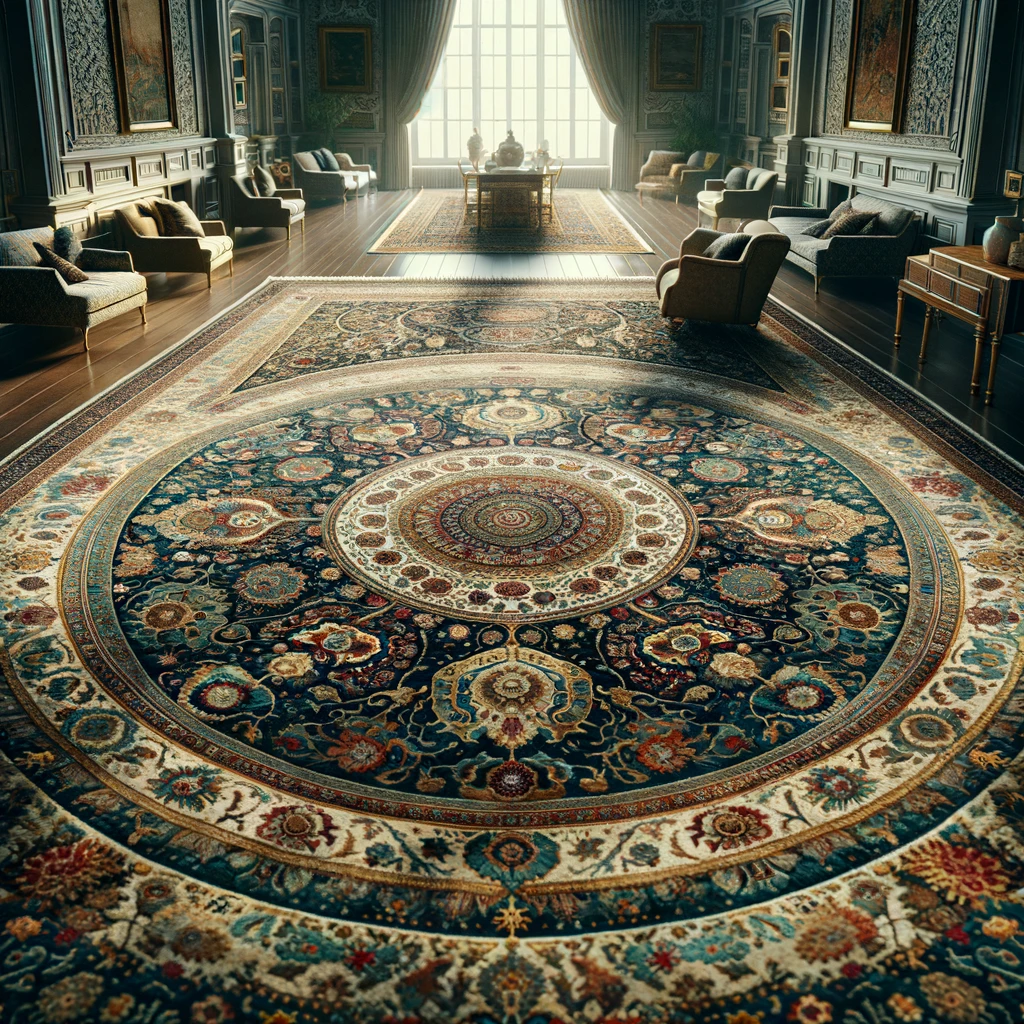Types of Oriental Carpets & Persian Rugs
A Guide to Oriental and Persian Rug Styles
The carpet industry offers a spectacular array of types, each boasting unique characteristics and charms.
Understanding these varieties is key to selecting the perfect carpet for your space.
The fundamental aspect that differentiates carpet types is the material used. Natural fibres such as wool, silk, and cotton stand out for their durability and texture, while synthetic options like nylon and polyester offer resilience and easy maintenance.
Another differentiator is the carpet's construction. The pile of a carpet, which refers to the density and length of its fibres, can be looped, cut, or a combination of both, known as cut-and-loop. Each style offers a different look and feel, from the luxurious softness of deep pile carpets to the neat, durable surface of short-looped ones. The method of construction, whether tufted, woven, needle-punched, or knotted, also plays a significant role in the carpet's texture and durability.
Design and pattern are crucial in defining a carpet's aesthetic appeal. While some carpets boast bold, contemporary designs, others exude classic elegance with traditional patterns.
The choice of colour, pattern, and texture must complement the interior décor, making the carpet a central piece of the room's design scheme.

Exploring the realm of rug types is like embarking on a global cultural journey. Among the most renowned are Persian and Oriental rugs, treasured for their intricate patterns, rich colours, and skilled craftsmanship.
Persian rugs, originating from Iran, are revered for their beauty and quality, featuring designs that range from floral motifs to intricate geometric patterns. Each region in Iran, from Tabriz to Isfahan, contributes its unique style, making Persian rugs not just decor items but pieces of cultural heritage.
Oriental rugs encompass a broader category, including Turkish, Indian, and Afghan rugs, among others. These rugs are known for their distinct weaving styles and cultural motifs, reflecting the artistic heritage of their respective regions.
Modern rug types, on the other hand, break away from traditional designs, offering minimalist or abstract patterns that align with contemporary interior trends. The choice of rug type can significantly impact the ambiance of a room. . A well-chosen rug can anchor the space, add warmth and texture, and serve as an artistic statement.
Most Renown Oriental Rug Type by Region
Each type of Oriental rug has its unique charm and story, making them more than just a luxury item; they are a piece of their country's cultural legacy. Collectors and enthusiasts of Oriental and Persian rugs appreciate them not only for their aesthetic appeal but also for their cultural, historical, and artistic significance.
Afghan Rugs
Delve into the history and characteristics of Afghan rugs, highlighting their rich heritage, unique patterns, and traditional weaving techniques.
Chinese Rugs
Explore the world of Chinese rugs, known for their ancient origins, intricate designs, and symbolic motifs that reflect China's rich cultural tapestry.
Berber Carpets
Originating from the Berber tribes of North Africa, particularly Morocco, this type of carpet is renowned for its rugged texture and resilient nature.
Greek Rugs
Read more on Greek antique rugs, embodying centuries of Hellenic artistry, featuring classical motifs, vibrant hues, and the enduring legacy of Greek craftsmanship.
Georgian Carpets
Discover Georgian rugs, originating from a region with a deep weaving history, characterized by their distinctive patterns, rich colors, and cultural significance.
Indian Rugs
Discover Indian rugs: intricate designs, rich colours, luxurious textures, embodying traditional craftsmanship and cultural motifs in each masterpiece.
Persian Rugs
Originating from what is now modern-day Iran, Persian rugs are celebrated for their unparalleled craftsmanship and enduring beauty.
Pakistani Rugs
Pakistani rugs, from the heart of South Asia, blend history and artistry, symbolizing exquisite craftsmanship and cultural significance with unique designs.
Turkish Rugs
Turkish rugs have a legacy steeped in history and artistry, and have always been a symbol of exquisite craftsmanship and cultural significance.
Unraveling Persian Rug Varieties
The world of Persian rugs is an intricate tapestry of history, art, and culture. Each rug is a testament to the rich Persian heritage, with diverse styles emanating from different regions of Iran. The city of Tabriz, for instance, is known for its sophisticated and symmetrically patterned rugs, while Isfahan rugs are celebrated for their majestic floral designs and vibrant colors.
Persian rug types vary not only in design but also in weaving techniques and materials used. The famed Kashan rugs, originating from the namesake city, are often made of silk and are known for their luxurious feel and opulence. In contrast, Qum rugs, although also silk-based, are distinguished by their high knot density and intricate detailing, depicting everything from medallion to garden designs.
Understanding Persian rug types requires an appreciation of their uniqueness and the stories they tell. Each knot, color, and pattern holds a meaning, often rooted in the weaver's personal story or the local traditions. The variations in Persian rugs make them not just a decorative item but a piece of living history, each with its distinct personality and charm.
The Historical Tapestry of Carpets
The history of carpets is as rich and varied as their designs. Originating thousands of years ago, carpets have been an integral part of human civilization, serving both utilitarian and artistic purposes.
Early carpets were simple, practical items used for warmth and comfort. However, as carpet-making techniques evolved, they became symbols of wealth and artistry.
The Persian Empire was among the first to elevate carpet weaving to an art form. The famous Pazyryk Carpet, believed to be the oldest surviving carpet, dates back to the 5th century BC and showcases the sophistication of early carpet weaving techniques.
Over centuries, the craft spread across the Silk Road, influencing styles and techniques in regions from China to Europe. In Europe, carpets were initially a luxury reserved for the nobility and the wealthy. It wasn't until the Industrial Revolution that carpets became more widely accessible, thanks to mass production methods.
Today, carpets are a ubiquitous part of home décor, with styles ranging from traditional hand-woven Persian and Oriental rugs to modern synthetic carpets, catering to a vast array of aesthetic preferences and practical needs.
Victoria & Albert Museum: A Glimpse into the Art of Carpets
The Victoria and Albert Museum in London showcases an impressive Islamic Middle East collection in Room 42, the Jameel Gallery. This exhibit highlights the deep cultural and historical essence of Persian rugs and Oriental carpets, transcending their decorative utility to serve as rich historical artifacts.
Spanning from the 7th to the early 20th century, the collection offers insight into the evolution of rug-making, featuring pieces from prominent weaving centers like Tabriz and Kashan, to lesser-known areas such as Kazvin. These carpets, known for their exquisite craftsmanship and intricate designs, encapsulate stories from ancient folklore, historical events, and the development of weaving techniques.
Among the collection, the Ardabil Carpet stands out as the museum's crown jewel, celebrated for its detailed craftsmanship and historical significance, dating back to 1539-1540. This carpet exemplifies the zenith of Safavid Court carpets' artistry, renowned for its intricate design and as a testament to the weavers' skill.
The Victoria and Albert Museum's Islamic Middle East collection not only offers a window into the artistic heritage of rug-making but also highlights the historical significance and cultural richness of these pieces, making it a vital resource for enthusiasts and scholars alike.


Joe Rugs - Carpet Expert
Hello! I'm Joseph Rugs, the founder of CarpetJoe.com and your guide through the intricate world of carpets. Born and raised in London with a deep-rooted passion for art and culture, I've explored the globe to bring the rich tapestry of carpet weaving right to your screen. My academic background in arts and humanities from Oxford has fueled my curiosity, leading me to uncover the stories behind every knot and weave. As a family man, my adventures are shared with my loved ones, enriching our lives with every piece of art we encounter. Join me as we explore the beauty and craftsmanship of carpets together.
Identifying the Best Carpet for Your Home
Choosing the best type of carpet for your home involves balancing aesthetics, functionality, and maintenance. The ideal carpet not only complements your home’s decor but also suits your lifestyle and practical needs. For high-traffic areas like living rooms and hallways, durable materials such as nylon or polypropylene are ideal, as they resist wear and stains. Wool carpets, while more luxurious, are perfect for adding warmth and elegance to bedrooms or low-traffic areas.
The pile type of a carpet - whether it's plush, textured, loop, or patterned - significantly impacts its look and feel. Plush carpets, with their smooth and soft finish, offer a luxurious feel, making them ideal for less busy areas. Textured and looped carpets, known for their durability, are better suited for areas that see more foot traffic. The carpet’s color and pattern also play a vital role in room aesthetics, with lighter colors making a room appear more spacious and darker hues adding a cozy feel.
Moreover, consider the maintenance requirements of the carpet. Some carpets require professional cleaning, while others are easier to clean and more resistant to spills and stains. Ultimately, the best carpet is one that aligns with your aesthetic preferences, practical requirements, and maintenance capabilities, ensuring both comfort and durability.
Deciphering Persian Rug Authenticity
Identifying an authentic Persian rug involves a deep understanding of its characteristics and nuances. Authentic Persian rugs are hand-knotted, a meticulous process that results in a dense and intricate pattern that cannot be replicated by machines. One of the first indicators of authenticity is the rug’s backside - the knots should be visible and uneven, a sign of hand weaving.
The quality of the materials used is another hallmark of authenticity. Genuine Persian rugs are typically made from natural fibers like wool, silk, or cotton, which provide a unique texture and luster. The dyes used in these rugs are traditionally natural, derived from plants and minerals, resulting in a rich, varied color palette that ages gracefully over time.
Regional designs and patterns also play a crucial role in identifying Persian rugs. Each region in Iran has its distinct weaving styles and motifs, reflective of its cultural heritage. For instance, rugs from Tabriz are known for their detailed and symmetrical patterns, while those from Qum showcase intricate floral designs and a finer weave. Understanding these regional characteristics is key to discerning the authenticity and origin of a Persian rug.

The Value and Fame of Persian Rugs
Persian rugs are not just luxurious home decor items; they are investments in art and history. The value of a Persian rug is determined by factors like age, rarity, craftsmanship, and condition. Antique Persian rugs, especially those that are well-preserved and feature unique designs, are highly sought after and can fetch substantial prices in the market.
The most valuable Persian rugs are often those with a rich history and exceptional craftsmanship. For example, the Tabriz rugs, known for their intricate designs and superb quality, are among the most valuable in the world. Similarly, silk rugs from Qum, renowned for their fine weave and detailed patterns, are highly prized.
Among the most famous Persian rugs is the above discussed Ardabil Carpet, housed in the Victoria and Albert Museum in London. Dating back to the 16th century, this rug is celebrated for its exquisite craftsmanship and historical significance. It epitomizes the pinnacle of Persian rug making, showcasing the skill and artistry that have made Persian rugs renowned worldwide.
Explore my Collection of Persian & Oriental Culture Inspired Gift Ideas found on Amazon
Frequently Asked Questions
The best type of carpet depends on your personal needs and preferences. For high-traffic areas, synthetic fibers like nylon or polypropylene offer durability and stain resistance. Wool carpets are ideal for a luxurious and warm feel, suitable for bedrooms and low-traffic areas. For those interested in eco-friendly options, natural fibers like sisal, jute, and seagrass are excellent choices.
There are numerous types of carpets, categorized by their material, construction, and style. Common materials include wool, nylon, polyester, and polypropylene. Construction types include loop pile, cut pile, and cut-and-loop pile, each offering different textures and appearances. Style-wise, there are traditional, contemporary, and minimalist designs, among others, to suit various interior decor themes.
To identify the kind of Persian rug you have, examine its design, color, weaving technique, and material. Authentic Persian rugs are hand-knotted and often made from natural materials like wool or silk. The design and motifs can also indicate its origin, as different regions in Iran have distinct styles. Consulting a rug expert or a reputable dealer can also provide you with detailed information about your rug.
The most valuable Persian rugs are typically those that are antique, rare, and exhibit exceptional craftsmanship. Rugs made from silk, featuring intricate designs and a high knot count, are often highly valued. Rugs from renowned weaving centers like Tabriz, Isfahan, and Qum are also among the most valuable, especially if they are well-preserved and have historical significance.
The Ardabil Carpet is arguably the most famous Persian rug. Currently housed in the Victoria and Albert Museum in London, this exceptional piece dates back to the 16th century and is renowned for its exquisite craftsmanship and historical importance. Its intricate design and large size make it a masterpiece of Persian rug making.
The main differences between Persian and Turkish rugs lie in their origin, design, materials, and knotting techniques. Persian rugs are from Iran and often feature intricate floral motifs with silk inlays, while Turkish rugs are from Turkey, known for geometric patterns and tribal designs.





